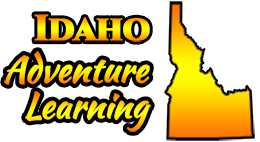The Importance of MILES
Submitted by Angela Becker on Tue, 2017-07-11 00:00
In my opinion, one of the things (if not THE thing) that makes Idaho so great and what draws so many people to the state to live and play is the large amount of public land. Over 60% of Idaho is public land, placing as 4th among all states for public land (1-Alaska, 2-Nevada, 3-Utah). Whether you are a hunter or angler, a mountain biker or hiker, a horse enthusiast, a kayaker or rafter, a bird watcher, an ATV rider, a fungus hunter (mmmm, morels), a skier or snowshoer, a snowmobile rider, or a motorcyclist or RV enthusiast, (and the list goes on!) you love the recreational opportunities all of that public land allows.
All of that recreational activity also means significant income for the state. Permits for hunting and fishing, boat and ATV registration fees, camp ground fees, fuel sales, outdoor equipment sales and rentals, food and souvenir sales, lodging taxes, etc. bring big dollars and employ,net opportunities. According to the Idaho Commerce website, "Idaho's $3.4 billion tourism industry employs more than 26,000 Idahoans and generates almost $500 million in local, state, and federal tax revenues."
But it's not all about the recreation. That same land is used for so many other human purposes: grazing of livestock, mining of minerals, logging, food production, energy production, providing the water to support our agricultural and day to day needs, etc. All of these also generate income for the state and help to strengthen the economy by providing employment opportunities.
However, all of the uses of our public lands and resources must be carefully monitored and regulated in order to ensure that the natural resources that make all of this possible are sustainable for the future. This is why the work done by MILES is so important.
The research being conducted through the MILES program strives to ensure that a balance is maintained. As seen in the video about population growth, climate change, and water scarcity in the Treasure Valley, it is vital to Idaho that we are informed and making wise decisions. The research being conducted by MILES is helping guide important management decisions regarding our state and it is being presented in a user friendly way such that the public can easily understand what is being done and why it matters. The training and resources provided for educators allows us to share with our students the importance understanding and managing our ecosystem services as well as the AWESOME educational career opportunities that are available. Through the MILES program, education creates enthusiasm which benefits us all!

Comments
Idaho tourism and recreation
Hello,
I read this blog and I found it facinating that you mentioned the tourism of our state. This is not a state that I would have thought to be rich in tourism, but you made some awesome points. Especially about how one thing will in turn affect others, like the service industry that tends to tourists. I tell people to make the drive to the Snake River Canyon, the City of Rocks, and Balanced Rock because I am a Rock Geek and that is what I love. I also love the MILES program and believe it to be a true benefit to all. :)
Tourism, Recreation, and Education
Hi Angela,
Your blog post REALLY resonated with me. As someone who frequently accesses the recreation Idaho has to offer, I strongly believe that all students in the state of Idaho should be able to have the same access to the state's wonderful amenities. I currently teach at Caldwell High School, a Title I school, where the majority of my students have not been exposed to the outdoors (recreation in Idaho). This happens because they do not have the funds or resources to spend time in the most beautiful parts of our state. For example, many are part of a family that has one car, and their family members often need to work in their spare time to make money. Students who want to get outside may not have a particular set of skills that allows them to do things like camping, hiking, biking, skiing, etc. It has been widely studied and found that poverty directly impacts our environment. If we do not teach our students in low-income areas the importance and beauty of our state, how are we going to ensure that it continues to be protected? Programs like the MILES program are fantastic, but they need to be implemented in areas that will have the most impact. How can we work together to get students from low-income areas into the Idaho wilderness to really appreciate the beauty of Idaho so that they, too, can work to protect and nurture our state.
Providing access for all...
Hello Shannon,
You bring up such an important question! Since I have been in Idaho, I have only worked in affluent areas. Many of my students have been skiing/snowboarding at Bogus, Tamarak, Brundage, and/or Sun Valley. They spend summers in McCall or boating on Lucky Peak or floating the Boise. Many get opportunities to see the beauty of Idaho in person. So yes, how do we help provide the resources and access to all students? Perhaps it's through school clubs and writing grants. Maybe there are local businesses that would be willing to partner with educators to provide the opportunities?
A quick search led me to the article I attached. I'll continue to see what I can find!
How a Denver Nonprofit Helps Bridge the Access Gap
Here's a link to an organization in Denver that works to provide the opportunities your are asking about